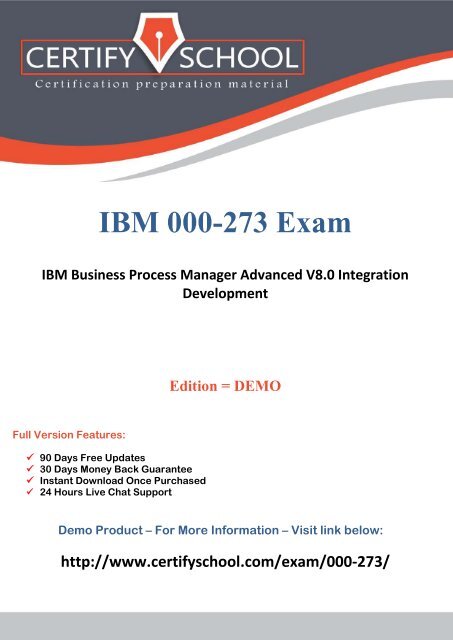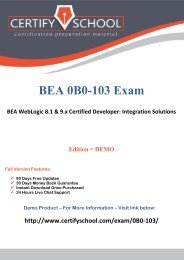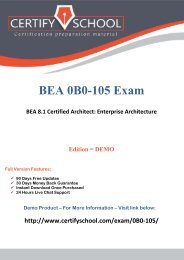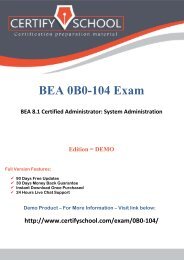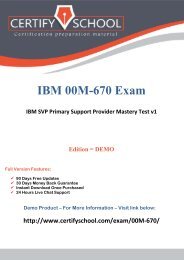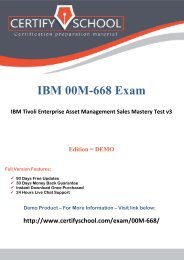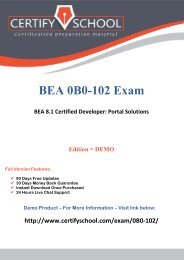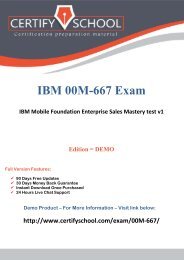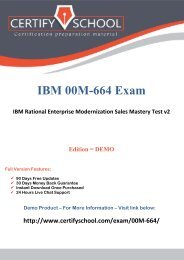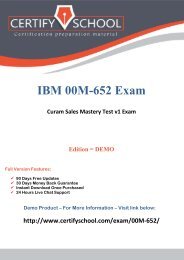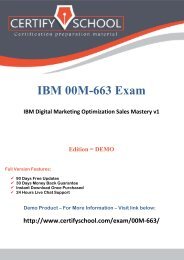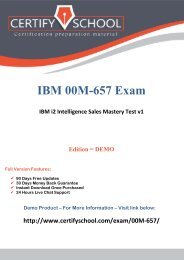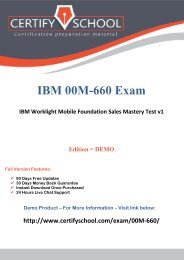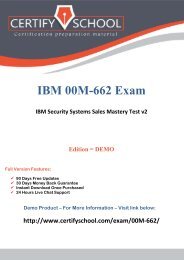IBM 000-273 Exam
You also want an ePaper? Increase the reach of your titles
YUMPU automatically turns print PDFs into web optimized ePapers that Google loves.
www.CertifySchool.com Certification Preparation Material (PDF)<br />
<strong>IBM</strong> <strong>000</strong>-<strong>273</strong> <strong>Exam</strong><br />
<strong>IBM</strong> Business Process Manager Advanced V8.0 Integration<br />
Development<br />
Edition = DEMO<br />
Full Version Features:<br />
90 Days Free Updates<br />
30 Days Money Back Guarantee<br />
Instant Download Once Purchased<br />
24 Hours Live Chat Support<br />
Demo Product – For More Information – Visit link below:<br />
http://www.certifyschool.com/exam/<strong>000</strong>-<strong>273</strong>/<br />
http://www.certifyschool.com/exam/<strong>000</strong>-<strong>273</strong>/<br />
Page | 1
www.CertifySchool.com Certification Preparation Material (PDF)<br />
Question: 1<br />
An integration developer has configured a BPEL business process for a customer, as shown below:<br />
What behavior will the integration developer observe when executing the flow<br />
A. It is possible for both Snippet2 and Snippet3 to execute.<br />
B. The execution order of the links entering Snippet2 and Snippet3 has no impact on the process flow.<br />
C. The gateway leading into Snippet5 will cause an error because there is a deadlock in the process flow.<br />
D. The gateway leading into Snippet4 will cause an error because the link exiting Snippet2 has no condition.<br />
Question: 2<br />
Answer: C<br />
An integration developer registers two Process Centers with each other and needs to share a child toolkit 'TK-Child'<br />
while preserving the dependency with its parent toolkit 'TK-Parent'. How should a integration developer accomplish<br />
this Set Snapshot status of:<br />
http://www.certifyschool.com/exam/<strong>000</strong>-<strong>273</strong>/<br />
Page | 2
www.CertifySchool.com Certification Preparation Material (PDF)<br />
A. TK-Child to 'New' and share it with other Process Centers<br />
B. TK-Child to 'Released' and share it with other Process Centers<br />
C. TK-Parent to 'Released', TK-Child to 'New' and share both toolkits with other Process Centers<br />
D. TK-Parent to 'Released', TK-Child to 'Released' and share both toolkits with other Process Centers<br />
Question: 3<br />
Answer: D<br />
A client requires that a new BPEL process return a fault message to the requester in case the process does not<br />
complete correctly. The integration developer has added a fault handler to the process to catch all exceptions. How<br />
should the integration developer return the fault message<br />
A. Use a throw activity of a business fault.<br />
B. Use a reply activity using a standard fault.<br />
C. Use a reply activity using a business fault defined in the interface.<br />
D. Use a rethrow activity in the fault handler on the process scope using a fault defined in the interface.<br />
Question: 4<br />
Answer: C<br />
An integration developer has implemented the business process shown in the exhibits below.<br />
http://www.certifyschool.com/exam/<strong>000</strong>-<strong>273</strong>/<br />
Page | 3
www.CertifySchool.com Certification Preparation Material (PDF)<br />
If the integration developer starts an instance of the ProcessA process with an input of "HELLO", which of the<br />
following strings will the LogSnippet snippet write to System.out If the integration developer starts an instance of<br />
the ProcessA process with an input of "HELLO", which of the following strings will the LogSnippet snippet write to<br />
http://www.certifyschool.com/exam/<strong>000</strong>-<strong>273</strong>/<br />
Page | 4
www.CertifySchool.com Certification Preparation Material (PDF)<br />
System.out If the integration developer starts an instance of the ProcessA process with an input of "HELLO", which<br />
of the following strings will the LogSnippet snippet write to System.out<br />
A. output1=ORIGINAL :: aString=ORIGINAL<br />
B. output1=ORIGINAL :: aString=MODIFIED<br />
C. output1=MODIFIED :: aString=ORIGINAL<br />
D. output1=MODIFIED :: aString=MODIFIED<br />
Question: 5<br />
Answer: C<br />
An integration developer is planning to create a BPEL process to help with the management of customer requests.<br />
The developer is intending to use a short-running process for the implementation because it has been determined<br />
that the performance of the process is a high priority, but the process must also be able to compensate for changes<br />
to the customer's request. What approach should the integration developer take while implementing this process<br />
A. Implement the short-running process as planned, but call the appropriate compensation activity from a fault<br />
handler in the process.<br />
B. Implement the short-running process as planned, but associate an undo-operation with the appropriate invoke<br />
activity in the process.<br />
C. Since compensation is not supported in short-running processes, implement a long-running process using<br />
compensation pairs.<br />
D. Since compensation is not supported in short-running processes, use a compensation handler and a compensation<br />
pair together in the<br />
log-running process<br />
Answer: B<br />
http://www.certifyschool.com/exam/<strong>000</strong>-<strong>273</strong>/<br />
Page | 5
www.CertifySchool.com Certification Preparation Material (PDF)<br />
Demo Product – For More Information – Visit link below:<br />
http://www.certifyschool.com/exam/<strong>000</strong>-<strong>273</strong>/<br />
Thanks for Using Our Product<br />
http://www.certifyschool.com/exam/<strong>000</strong>-<strong>273</strong>/<br />
Page | 6


